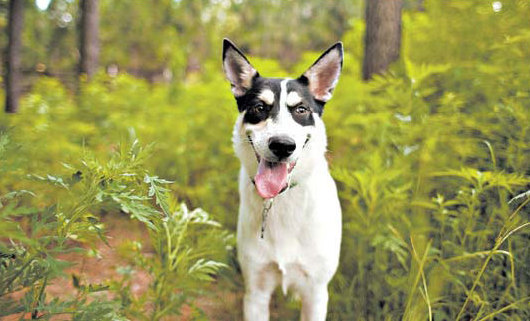Carolina dog's DNA tracks lead a long way back
|
Dogs like Peony have pointed lupine faces, markings that look like eyes, and white fishhook tails. John W. Adkisson for The New York Times |
BISHOPVILLE, South Carolina - On the swampy Lynches River flood plain here, seven of Don Anderson's primitive medium-size dogs spring into high alert at approaching strangers.
These are Carolina dogs- friendly, but clearly different from other dogs. Several rush to the gate, their whole bodies wagging eagerly. Others sprint off and take position - their jackal ears fully erect, their fishhook tails twitching. A black pup scrabbles into an underground den.
Walking into the pen is dangerous for only one reason: one of the dogs' defining habits is digging snout pits, or soccer-ball-size holes in the ground, perhaps to root for grubs or munch the soil for nutrients.
"It's like a lunar landscape," Mr. Anderson, 79, warns a visitor.
Some Carolina dogs still live in the wild, and local people have long thought they were one of the few breeds that predated the European arrival in the Americas: "Our native dog," as Michael Ruano, another enthusiast who often works with Mr. Anderson, put it. "America's natural dog."
Now, a new study of canine DNA backs up the folklore. A team led by Peter Savolainen at the Royal Institute of Technology in Sweden has reported that several dog breeds in the Americas - among them the Peruvian hairless, the Chihuahua and the Carolina dog - are without some genetic markers indicative of European origin, suggesting they arrived in an earlier migration from Asia.
Current theory speculates that dogs are descended from wolves that became attached to humans 12,000 to 33,000 years ago.
But where that may have happened is not settled. Some say the Middle East. Others point to an area south of the Yangtze River in China. Dr. Savolainen's study provides more evidence for the China hypothesis and lends support to the idea that the earliest domesticated dogs crossed the Ice Age land bridge known as Beringia some 12,000 years ago.
Carolina dogs, then, could be camp followers that wandered off from their Paleo-Indian masters.
I. Lehr Brisbin, a biologist with the Savannah River nuclear power plant near Aiken, South Carolina, is the man most responsible for interest in the breed. In the early 1970s, Dr. Brisbin often came upon these wild dogs near the plant. He took a few in and today has his own pack.
Dr. Brisbin got the Carolina dog recognized by the United Kennel Club and described some of its traits, including the fishhook tail and the somewhat lupine face. The dogs cooperate as a pack when they hunt a field mouse or a rabbit, possibly using their white hindquarters as signals.
"That white fishhook can be hoisted like a white-tailed deer's and can flash back and forth," he said. "I saw them do it, and I saw the rest of the pack honor it."
Most Carolina dogs are ginger-colored, like Australian dingoes, but they can also be black and piebald. Most are short-haired. Some have tiny patches above their distinctive almond eyes, that look like a spare set of eyes, what Mr. Anderson calls "spirit eyes."
DNA studies may soon make it easier to assert the Carolina's distinctions from other dogs.
Mark Eden, an enthusiast, said the journals of the 16th-century Spanish explorer Hernando de Soto include possible references to Carolina dogs.
And in 1806, as he and William Clark crossed North America, Meriwether Lewis writes of an "Indian dog" that is "party coloured; black white brown and brindle" with "ears erect and pointed like those of the wolf" and used by American Indians to hunt elk.
In the late 19th and early 20th centuries, the dog's wildness and its ginger coat - and probably its use as a hunting dog - led to the name "yaller dog."
Enthusiasts make the case for the dog's inclusion among the ancient dogs the world over: the Canaan dog of Israel, the Santal hound of India, the Jindo of Korea, the Telomian of Malaysia, the New Guinea singing dog, the Kintamani dog of Bali, the African basenji.
These dogs possess many of the qualities Dr. Brisbin and Mr. Anderson describe. The primitive dogs started living near people tens of thousands of years ago, finding a place just out of sight of humans - where, if the studies hold up, they steadfastly remain.
The New York Times




















